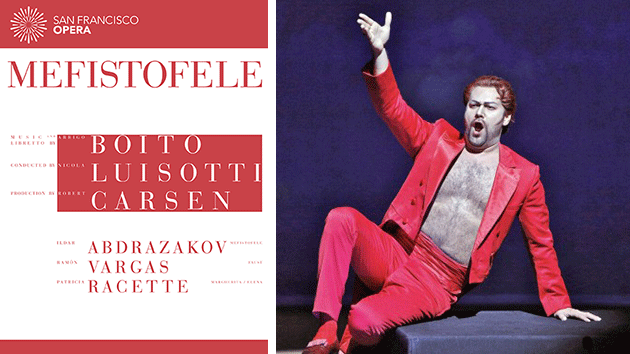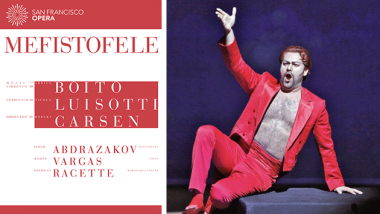
What better way to get your New Year off to a great start than with three videos that have a strong relationship with San Francisco Opera? Anyone who suggests that 18th-century opera has little relevance to 2015 will likely change their tune after viewing the most exceptional of the lot, Royal Opera House, Covent Garden’s recent production of Mozart’s Don Giovanni,, conducted by SFO Music Director Nicola Luisotti.
It is impossible to discuss the partnership between director Kasper Holten, set designer Es Devlin, video designer Luke Halls, costumer Anja Vang Kragh, lighting designer Bruno Poet, and choreographer Signe Fabricius without giving away the many surprises that unfold throughout their virtually three-dimensional presentation. Let’s just say that 2001, Star Trek and their successors have found their operatic equivalent, not on a distant galaxy, but rather in the U.K.
Bay Area opera lovers may already feel they “know” baritone Marius Kwiecien’s Don Giovanni from his June 2007 San Francisco performance. But here, in Holten’s outstanding production, Kwiecien is a revelation. Not only are the warmth and power of his exceptionally handsome voice inherently seductive, but the way he uses them to convey Holten’s conception also amounts to pure genius. With face and body as fluid as his instrument, Kwiecien portrays a surprisingly appealing, yet downright dastardly Don who seemingly unravels in the end, only to ultimately prevail.
Luisotti’s conducting triples the impact. His witty continuo improvisations on fortepiano amount to a running editorial commentary on the proceedings, and his tempo fluctuations add a musically convincing, surprisingly romantic depth to Mozart’s classic score. Listen to how slowly he takes Don Giovanni’s mandolin serenade, “Deh vieni alla finestra,” and how he gives Kwiecien the freedom to emit meltingly soft tones. Note how he slows at the ends of Zerlina’s “Vedrai carino” and Donna Anna’s “Non mi dir,” helping his singers convey a surprising range of emotions. Rarely will you hear Don Ottavio delivers a more nuanced or flexible “Il mio tesoro.” This is brilliant conducting, as indispensable as Carlo Maria Giulini’s on his Don Giovanni.
The artistry of the other singers is anything but ordinary. The vocally and histrionically gifted Alex Esposito, dressed in a modern update of clown pants, makes much more than a dolt out of Leporello. Malin Byström creates a beautifully sung Donna Anna who gives Don Giovanni every reason to seduce her.
Véronique Gens’ Donna Elvira fires away with Schwarzkopf-like intensity, only to turn on a dime and emit meltingly sweet tones. Her “Mi tradì” is a triumph. She may not produce consistently heavenly soft sounds in the sublime ballroom trio, but few modern singers can. Antonio Poli’s Don Ottavio betrays the occasional push at the top of the range, and less than impeccably clear runs in “Il mio tesoro,” but the innocent strength, beauty, and clarity of his singing nonetheless create one of the finest Ottavios I’ve encountered. Elizabeth Watts is a lovely and very naughty Zerlina who sounds best higher in her range, and Dawid Kimberg a handsomely voiced Masetto. Ideally, the Commendatore’s voice would be darker and deeper than Alexander Tsymbalyuk’s, but it would certainly be as strong and steady.
Auditioned in superior, two-channel Blu-ray format, the sound is exceptional, with far more air, resonance, and non-digital smoothness than on the two Blu-rays from SFO discussed below. Even if you’ve seen and heard 100 Don Giovannis, this is one you will not forget.
Mefistofele
Though it may be unusual for a production of Arrigo Boitoʼs Mefistofele, to suggest that sin is more satisfying than salvation, there’s no question which one comes out on top in director Robert Carsen’s production. As arrestingly colorful as when it first appeared at SFO in 1986, it’s tailor-made for DVD.
Several great basses, most recently Samuel Ramey, built their careers on portraying devils with panache. Ildar Abdrazakov, in his initial assumption of the title role, sings with great strength and surety (despite lacking earth-shaking lows), but his characterization is still developing. Far too much of the time, grand, sweeping gestures with bare arms and chest replace the gross and subtle changes of tone and inflection that make for great artistry. His may be an enjoyable devil, but not one to stake your life on.
Ditto for the two other principals. Soprano Patricia Racette (Margherita, Elena) is always endearing. But, as the late great vocal critic, John Steane, was wont to say, the vibrations had already begun to loosen on top when she performed the role in October 2013. As a result, pitch suffers on her top notes in her great aria, “Lʼaltra notte in fondo al mare,” and sweetness too often cedes to stridency. Racette also fails to make all she could of the low notes in Boito’s great statement.
Tenor Ramón Vargas (Faust) sings beautifully, but rarely opens in volume to deliver the thrills we want from an Italian tenor. In secondary roles, Erin Johnson makes the biggest impression, not just for her voice, but also for her willingness to have fun. Luisotti conducts idiomatically, but with the awareness that if he shows his full hand all the time, he may very well upstage his singers.
Many operagoers love Carson’s Mefistofele so much, for both its sanctity and kink, that the cast’s vocal deficiencies won’t bother them. But those for whom Mefistofele remains an acquired taste, and who prefer revelry to religion, may want more sly style and devilish humor than Abdrazakov delivers.
I Capuleti e i Montecchi
The more you listen to Bellini’s I Capuleti e i Montecchi (1830), the more you may recognize the music of Norma in the making. Based on Luigi Scevolaʼs version of the tragedy of Romeo and Juliet, rather than Shakespeare’s, its most heartbreaking arias and duets call for singers who meld consummate bel canto technique with voices filled with pain and suffering. This San Francisco Opera production captures the cast of the 2012 production, directed by Vincent Broussard and conducted by Riccardo Frizza.
In perhaps her best undertaking for San Francisco Opera, soprano Nicole Cabell (Giulietta) sings with admirable sincerity and vocal beauty. Lacking, however, is the ability to soften, sweeten, and shade as she approaches the top of her range. Too often, strength of utterance replaces the fragility at the core of Giulietta’s character. Nor can she deliver Giulietta’s great aria, “Eccomi in lieta vesta … Oh quante volte” with soaring coloratura embellishments, as Bellini would have expected. Listen to Beverly Sills’ priceless 1968 rendition to understand how much is missing.
Only superlatives apply to the technique, conviction, surety, and stunning high range of mezzo-soprano Joyce DiDonato (Romeo). Whether hers is a voice that will tear your heart out as it should, or leave you only partially fulfilled, is another question. But there’s no disputing that her command is total, and her duets with Cabell extraordinarily beautiful.
Saimir Pirgu (Romeo’s rival, Tebaldo) sings sincerely and sturdily, but without sufficient beauty to make you wish to hear him again. As has frequently been the case at SFO, he also falters at the very top of his range. Bass Eric Owens (Giulietta’s father, Capellio) sings marvelously, as does Ao Li (as the physician who slips Giulietta the fateful love potion). But where Owens knows how to move theatrically, and how to stand still and rely on voice alone, Li tries too hard and frequently hams it up. Director Boussard should have spent more time with this young singer, who had the voice to win both Plácido Domingo's Operalia Competition and the Metropolitan Opera National Auditions.
Frizza conducts with a genuine sense of bel canto flow, but cannot alter the fact that Vincent Lemaire’s sets and Guido Levi’s lurid lighting are ridiculous. Has anyone adequately explained why Cabell sings part of her great aria with her back to the audience, precariously perched on one leg on the edge of a sink, and why valiant chorus members and principals are required to repeatedly navigate bleachers in high heels? Yes, we have been told that the flowers in the mouths of women choristers are symbolic of their silence. But ultimately, they, like the lighting, seem less about the opera than the designers’ emotionally irrelevant decorative conceits.

